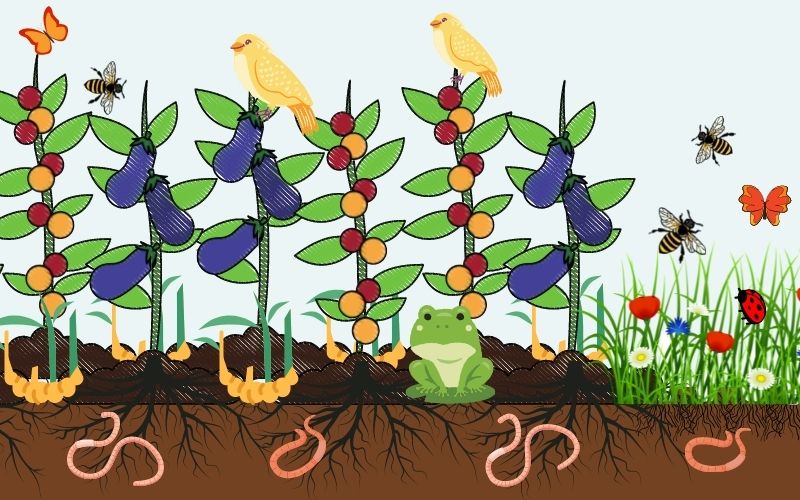You may be aware that the loss of biodiversity or biological diversity is a big problem worldwide and may be supportive of programs that address this issue and want to help out yourself.
We all feel very emotional when we hear that large animals, like pandas, elephants, and rhinos, may be gone forever. Despite this, it can sometimes be hard to understand why having different types of species around is so important.
Luckily for us as vegetable gardeners, we have to look no further than our own gardens to understand why biological diversity is so important.
Benefits of growing a biodiverse vegetable garden
1. You’ll be able to harvest and eat different types of vegetables
Each type of vegetable has a unique taste, color, flavor, and nutrition. Growing a range of different vegetables will help you harvest them and make meals that are not only more colorful and exciting but also rich in nutrients.
Different parts of plants, including roots, stems, fruits, and leaves, are grown as vegetables. Growing a range of vegetables with different harvestable parts, including fruiting vegetables, root vegetables, and leafy vegetables, will help you add different textures to your diet and will be able to cook different types of dishes using your vegetables.
2. To attract more pollinators into your garden
Attracting bees and other pollinators becomes easier in a biologically diverse vegetable garden. You don’t have to depend on your vegetable plants only, you can also plant nectar and pollen-rich flowers in and around your garden to attract more pollinators.
Pollination happens best when a larger number of suitable pollinators visit each flower. Attracting different types of pollinators into your garden will make it more likely that your plants are well pollinated, which leads to more vegetables that are of high quality.
3. To attract more animals that are beneficial for pest control
Attracting and maintaining controlled populations of ladybug beetles, frogs and toads, spiders, and other beneficial animals is an easy and cheap organic method of pest control. Then, if a pest infestation does happen, you won’t have to waste any time trying to attract these beneficials and they will be able to get to work right away.
To be able to attract and maintain beneficials in your garden, your garden should be able to provide these beneficials with enough food and shelter. A diverse range of both vegetable and flowering plants, as well as high soil diversity, will make it more likely that these beneficials will have enough insects and other prey to feed on. A biodiverse vegetable garden is also more likely to have better hiding places and shelter for the beneficials.
In addition, some insects such as the hoverfly, have pest-eating larvae but adults only feed on nectar and pollen. So having enough nectar and pollen-rich plants will help maintain adult hoverfly populations in your garden.
4. To maintain the health of the soil in your garden
Growing a diverse range of vegetables can help maintain the health of your soil in different ways.
Different types of vegetable plants have slightly different nutritional needs, despite having the same nutrient requirements. For example, corn needs a large supply of nitrogen from the soil, while beans and other legumes need very little to no nitrogen from the soil, as they have nitrogen-fixing bacteria in their root nodules. Growing corn and beans or other legumes near each other balances out the nutrients drawn out from the soil.
The depths to which roots grow also differ between different types of vegetables, with some growing deep roots while others can only grow shallow roots. Growing both shallow root vegetables and deep root vegetables helps the plants get nutrients from different layers of the soil, without depleting any particular layer. In addition, a balance of roots in both layers creates more microscopic tunnels through which air, water, and nutrients can circulate through.
5. You’ll be able to use garden space more efficiently
Growing different types of vegetables will allow you to grow the vegetables closer together, helping you save on space.
If you grow just one type of vegetable, you’ll have to keep a minimum about of space between each plant so that they don’t compete for nutrients or sunlight. If you are growing different types of vegetables, you can mix the types of vegetables.
For example, you can grow shade-loving shorter plants, such as ginger and onion, between taller plants that need more exposure to the sun, such as tomato and eggplant/aubergine/brinjal.
How to make your vegetable garden biodiverse
As the vegetable gardener, you’ll have to make sure that you start by having a range of different types of plants both in and around your vegetable garden. This doesn’t mean that you will have to grow more types of vegetables than you can manage.
Instead, you can leave a border near your vegetable garden to grow wildflowers, add flowering plants or herbs, or simply locate your vegetable garden in an already biodiverse area of your garden, provided that all other requirements are met.
After you’ve chosen the types of vegetables you’d like to grow, you can try pairing them up with matching plants, which can be other vegetables, herbs, or flowering plants. This will help you maximize the space you have and make it more likely that you reap the benefits of the biodiverse vegetable garden.
Another very important rule to follow is to never use pesticides or any harmful chemicals in your garden. You may be able to plant different vegetable plants, but you will not get beneficial insects and other animals visiting and won’t be able to maintain soil diversity if you do use harsh chemicals. Overtime time this can even affect the health of your plants, as you will have to spend more time, energy, and even money to try and get rid of diseases, pests, and nutrient deficits.
Which benefit of a biodiverse vegetable garden do you think is the most important for you? – Let us know in the comments below.

